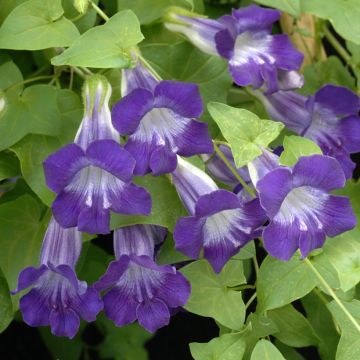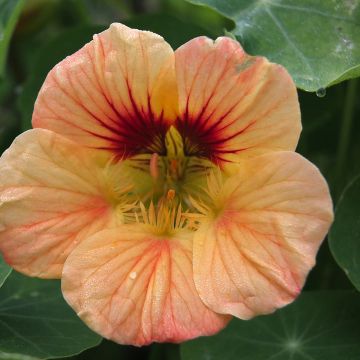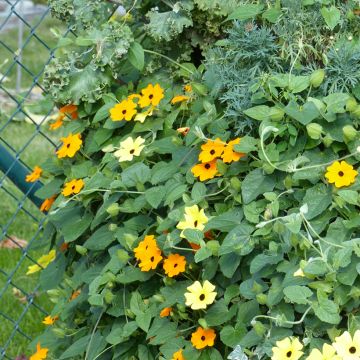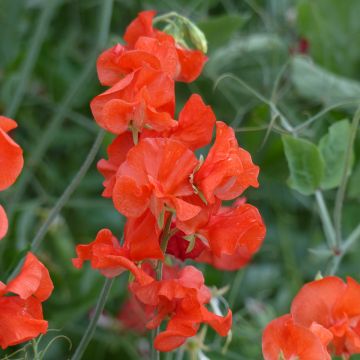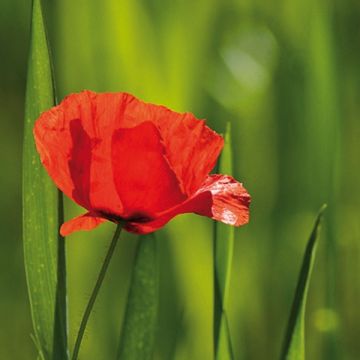

Asarina antirrhiniflora - Climbing Snapdragon seeds
Asarina antirrhiniflora - Climbing Snapdragon seeds
Asarina antirrhiniflora Mixed
Climbing Snapdragon Vine, Violet Twining Snapdragon
Special offer!
Receive a €20 voucher for any order over €90 (excluding delivery costs, credit notes, and plastic-free options)!
1- Add your favorite plants to your cart.
2- Once you have reached €90, confirm your order (you can even choose the delivery date!).
3- As soon as your order is shipped, you will receive an email containing your voucher code, valid for 3 months (90 days).
Your voucher is unique and can only be used once, for any order with a minimum value of €20, excluding delivery costs.
Can be combined with other current offers, non-divisible and non-refundable.
Why not try an alternative variety in stock?
View all →This plant carries a 6 months recovery warranty
More information
We guarantee the quality of our plants for a full growing cycle, and will replace at our expense any plant that fails to recover under normal climatic and planting conditions.
Would this plant suit my garden?
Set up your Plantfit profile →
Description
The plants in this mixture of Asarina antirrhiniflora, also known as maurandias or snapdragon-flowered asarines, produce long flowers reminiscent of those of snapdragons, ranging in shades of red, pink, or blue-violet, with a cream lip speckled with darker tones, from summer until the first frost, even in winter when protected from frost. Their pale green foliage forms a sumptuous backdrop to their delicate flowering, which even occurs in shade. Perennials often grown as annuals, these climbing or trailing plants can climb any support or gracefully trail from hanging baskets and pots. They are easy to sow, love warmth, thrive in moist but well-drained soil, and tolerate all exposures.
Asarina antirrhiniflora, sometimes called Maurandya, is a perennial climbing plant native to the southern United States and Mexico. The mixture we offer combines blue-violet, pink, or red forms of this plant from the plantain family. They are vigorous lianas that quickly reach heights of 1.20 to 1.80 m (3.9 - 5.9 ft). The flexible stems are adorned with heart-shaped leaves with entire edges, evergreen or deciduous, pale green to bluish, hairy, trilobed, resembling those of ivy. Flowering begins in July and continues until the first frost. If the plants are stored frost-free, they will continue to bloom in winter. The tubular flowers are axillary, trumpet-shaped with 5 tapering lobes, 2.5 cm (1 in) in length. Depending on the plants, they are pink, blue-violet, or dull red. The inside of the corolla is illuminated with a speckled cream or pale yellow throat. The flowers give way to the formation of fruits, which are capsules containing several easily germinating seeds.
Climbing asarines are ideal plants for unheated verandas. Outdoors, their rapid growth allows them to climb in one season on shrubs or small trees, as well as on fences and trellises. Like morning glories or sweet peas, they can be hung in baskets or allowed to sprawl in cool rockeries or over low walls. The key is to provide them with warmth, non-scorching sun, and consistently moist soil.
Attention, seeds reserved for highly experienced gardeners accustomed to sowing very fine seeds. These seeds are as fine as dust, barely visible to the naked eye.
Report an error about the product description
Flowering
Foliage
Plant habit
Botanical data
Asarina
antirrhiniflora
Mixed
Plantaginaceae
Climbing Snapdragon Vine, Violet Twining Snapdragon
Maurandya, Lophospermum
Cultivar or hybrid
Other Asarina seeds
View all →Planting and care
Sow from early February to mid-April in good soil, barely covering the seeds with a very thin layer of compost or vermiculite. Germination takes 14 to 21 days at 18-20°C. Light promotes germination. It may be useful to enclose the sowing in a polythene bag.
When they are developed enough to be handled, transplant the seedlings into 7.5 cm (2.8 in) pots and grow them in a cooler environment, repotting if necessary. For outdoor planting, gradually acclimatise the young plants to outdoor conditions and transplant them at the end of spring, after the last frost. Space them 30cm (11.8 in) apart. Choose a sunny but not scorching location, a sheltered exposure, and plant in moist but well-drained soil. In acidic soil, a pinch of lime is useful before planting to alkalize the substrate. It is important to provide support for the plant to climb on: a trellis, chains, etc... These asarines grow well in a greenhouse or conservatory, in 18 to 20 cm (7.9 in) diameter pots. The temperature should not drop below 5 to 7°C in winter.
Sowing period
Intended location
Planting & care advice
This item has not been reviewed yet - be the first to leave a review about it.
Similar products
Haven't found what you were looking for?
Hardiness is the lowest winter temperature a plant can endure without suffering serious damage or even dying. However, hardiness is affected by location (a sheltered area, such as a patio), protection (winter cover) and soil type (hardiness is improved by well-drained soil).

Photo Sharing Terms & Conditions
In order to encourage gardeners to interact and share their experiences, Promesse de fleurs offers various media enabling content to be uploaded onto its Site - in particular via the ‘Photo sharing’ module.
The User agrees to refrain from:
- Posting any content that is illegal, prejudicial, insulting, racist, inciteful to hatred, revisionist, contrary to public decency, that infringes on privacy or on the privacy rights of third parties, in particular the publicity rights of persons and goods, intellectual property rights, or the right to privacy.
- Submitting content on behalf of a third party;
- Impersonate the identity of a third party and/or publish any personal information about a third party;
In general, the User undertakes to refrain from any unethical behaviour.
All Content (in particular text, comments, files, images, photos, videos, creative works, etc.), which may be subject to property or intellectual property rights, image or other private rights, shall remain the property of the User, subject to the limited rights granted by the terms of the licence granted by Promesse de fleurs as stated below. Users are at liberty to publish or not to publish such Content on the Site, notably via the ‘Photo Sharing’ facility, and accept that this Content shall be made public and freely accessible, notably on the Internet.
Users further acknowledge, undertake to have ,and guarantee that they hold all necessary rights and permissions to publish such material on the Site, in particular with regard to the legislation in force pertaining to any privacy, property, intellectual property, image, or contractual rights, or rights of any other nature. By publishing such Content on the Site, Users acknowledge accepting full liability as publishers of the Content within the meaning of the law, and grant Promesse de fleurs, free of charge, an inclusive, worldwide licence for the said Content for the entire duration of its publication, including all reproduction, representation, up/downloading, displaying, performing, transmission, and storage rights.
Users also grant permission for their name to be linked to the Content and accept that this link may not always be made available.
By engaging in posting material, Users consent to their Content becoming automatically accessible on the Internet, in particular on other sites and/or blogs and/or web pages of the Promesse de fleurs site, including in particular social pages and the Promesse de fleurs catalogue.
Users may secure the removal of entrusted content free of charge by issuing a simple request via our contact form.
The flowering period indicated on our website applies to countries and regions located in USDA zone 8 (France, the United Kingdom, Ireland, the Netherlands, etc.)
It will vary according to where you live:
- In zones 9 to 10 (Italy, Spain, Greece, etc.), flowering will occur about 2 to 4 weeks earlier.
- In zones 6 to 7 (Germany, Poland, Slovenia, and lower mountainous regions), flowering will be delayed by 2 to 3 weeks.
- In zone 5 (Central Europe, Scandinavia), blooming will be delayed by 3 to 5 weeks.
In temperate climates, pruning of spring-flowering shrubs (forsythia, spireas, etc.) should be done just after flowering.
Pruning of summer-flowering shrubs (Indian Lilac, Perovskia, etc.) can be done in winter or spring.
In cold regions as well as with frost-sensitive plants, avoid pruning too early when severe frosts may still occur.
The planting period indicated on our website applies to countries and regions located in USDA zone 8 (France, United Kingdom, Ireland, Netherlands).
It will vary according to where you live:
- In Mediterranean zones (Marseille, Madrid, Milan, etc.), autumn and winter are the best planting periods.
- In continental zones (Strasbourg, Munich, Vienna, etc.), delay planting by 2 to 3 weeks in spring and bring it forward by 2 to 4 weeks in autumn.
- In mountainous regions (the Alps, Pyrenees, Carpathians, etc.), it is best to plant in late spring (May-June) or late summer (August-September).
The harvesting period indicated on our website applies to countries and regions in USDA zone 8 (France, England, Ireland, the Netherlands).
In colder areas (Scandinavia, Poland, Austria...) fruit and vegetable harvests are likely to be delayed by 3-4 weeks.
In warmer areas (Italy, Spain, Greece, etc.), harvesting will probably take place earlier, depending on weather conditions.
The sowing periods indicated on our website apply to countries and regions within USDA Zone 8 (France, UK, Ireland, Netherlands).
In colder areas (Scandinavia, Poland, Austria...), delay any outdoor sowing by 3-4 weeks, or sow under glass.
In warmer climes (Italy, Spain, Greece, etc.), bring outdoor sowing forward by a few weeks.

































